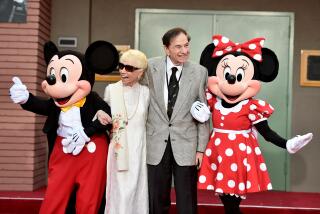Walt Disney -- prince or toad?
Even before it opens later this week, Disney’s new animated feature, “The Princess and the Frog,” is already considered something of a cultural and animation landmark. After centering cartoons on a Middle Easterner (“Aladdin”), a Native American (“ Pocahontas”), an Asian (“Mulan”), and a Hawaiian (“Lilo & Stitch”), Disney animation has entered the post-racial era. The new film features a black protagonist alongside the green one.
It has been a long time coming, but it is an event that, if you believe Disney detractors, would have old Walt spinning in his grave (or his cryogenic chamber).
That’s because there is a long-standing belief among those detractors that Walt Disney was anything but the amiable, avuncular, kind-hearted figure he appeared to be on his television program and in his promotions. The real Disney, so this version goes, was a rabid reactionary who was intemperate, crabbed and mean -- racially and ethnically insensitive at best, a racist and anti-Semite at worst. Under his supervision, the Disney studio was inhospitable to minorities, few of whomwere said to have workedthere and they were virtually verboten on the screen, except to be ridiculed. Disney’s was a white, Protestant, middle-class studio and fantasy. Minorities need not apply.
How much of this portrait was the product of a smear campaign by Walt’s enemies and how much a product of Walt’s own unenlightened attitudes is difficult to determine. What one can say is that the truth about Walt Disney seems much more complicated and nuanced than either his enemies or supporters would have you believe.
Labor fight
Disney came by those enemies honestly when his animators staged a strike in 1941 complaining of paternalism and low wages and Walt responded by hustling the supposed union ringleaders off the lot and firing other union members to quash their organizing. Even after the four-month-long strike was settled -- under duress by the federal government -- the wounds did not heal. Disney would feel betrayed for the rest of his life by what he saw as ungrateful employees. The aggrieved employees got their own measure of revenge by portraying Walt thereafter in the least flattering light. Most of what we hear about Disney as a racist or anti-Semite was circulated by animators who had struck in 1941. I know, because several of them made the same charges to me when I was working on my biography of Disney.
Unquestionably, especially after the strike, Disney was a political conservative by way of anti-communism. He was certain that the strike was instigated by communist agents in the Screen Cartoonists Guild who were determined to sully the Disney brand -- this after Disney had been extolled by the left for years for his collaborative enterprise and exemplary working conditions.
Though Walt was something of a political naïf -- he had no interest in politics before the strike and little after it -- he was an easy recruit for the most reactionary elements in Hollywood. They enlisted him to join an organization called the Motion Picture Alliance for the Preservation of American Ideals that was really dedicated less to preserving American ideals than to ridding the film industry of leftists. This was Walt’s war too. Still, the organization was so toxic to much of Hollywood -- many of its members were known anti-Semites -- that even such staunch anti-communists as Louis B. Mayer and Jack Warner declined to join.
And yet even if Walt were guilty by association -- and he was -- it would be unfair to label him an anti-Semite himself. There is no evidence whatsoever in the extensive Disney Archives of any anti-Semitic remarks or actions by Walt -- only a few casual slurs by his brother Roy. Moreover, Joe Grant, the one-time head of the Disney Model Department and an esteemed story man, was Jewish, as was Harry Tytle, a longtime production executive, and the head of the Disney merchandise arm was a Jewish entrepreneur named Herman “Kay” Kamen, with whom Walt was especially close. Though the studio, as one of the only ones in Hollywood not operated by Jews, had the reputation of being less than minor- ity friendly, prompting Tytle to confess to Walt that he was half-Jewish. Tytle told me that Walt responded by quip- ping that he’d be better if he were all Jewish.
This doesn’t mean that Walt was particularly sensitive to minorities. He was, after all, a Midwestern Protestant by temperament as well as birth, and he seemed to subscribe to many of the ethnic stereotypes of his time. “The Three Little Pigs” featured the wolf dressed as a Jewish peddler -- a characterization that the American Jewish Congress protested was so “vile, revolting and unnecessary as to constitute a direct affront to the Jews.” (The scene was reanimated years later.) Walt could refer to Italians as “garlic eaters” and used a variety of crude terms for blacks, according to materials at the Walt Disney Archives -- though there didn’t seem to be any malice in these words, just obtuseness. To this day, many regard the crows in Dumbo as broad stereotypes. But Walt was no closet racist. At home he always preached racial, religious and ethnic tolerance to his two daughters.
The main evidence for Walt’s racial insensitivity, however, is “Song of the South,” his 1946 combination of live action and animation based on the Southern folk tales of Joel Chandler Harris, known as Uncle Remus, which, though set in the Reconstruction era, makes the black former slaves seem dependent upon and excessively grateful to their former owners. From any modern racial perspective, the film is cringe-inducing, and it isn’t much mitigated by Remus, played by James Baskett, being the most dignified and sympathetic figure in the movie. (Its reputation is such that to this day it is not available on DVD in this country.) Indeed, “Song of the South” seems to give credence to the idea that Walt was clueless when it came to race.
A firestorm
But Walt anticipated these criticisms and actually went to great lengths to make the film as racially sensitive as he could. He hired a Jewish left-wing screenwriter, Maurice Rapf, to do a draft of the script because, as he told Rapf, “You’re against Uncle Tomism and you’re a radical.” Before signing Baskett, he approached the black actor, singer and leftist activist Paul Robeson to play Remus and asked him to review the script. And he sent the script to a number of black notables for comment, including the actress Hattie McDaniel; the secretary of the NAACP, Walter White; and, via his friend producer Walter Wanger, Howard University scholar Alvin Locke. Walt even did something that he had done on no previous film: He invited White to the studio to work on revisions with him. White begged off, saying he was too busy. In short, Walt did everything he could plausibly do to get input from the black community. The usually peremptory man was anything but peremptory here.
Yet Walt was more politically obtuse than he was racially obtuse. When the film opened, he was stunned by the firestorm of protest from African Americans who thought it was condescending and demeaning, among them Walter White, who complained to the New York Times that the black-white relationships in the film were a “distortion of facts.” Former admirers, like the producer Billy Rose, condemned Walt as well. One group, the Theatre Chapter of the National Negro Congress, picketed theaters where the film was shown. Walt came to blame the black actor Clarence Muse, ironically one of those he had solicited for suggestions. Muse, he said, had wanted the role of Remus, and when he didn’t get it, he turned to black newspapers to attack the film.
But remarkably for a man who took everything personally, this disappointment did not sour Walt on race relations the way the strike had soured him on unions. He successfully fought to get Baskett an honorary Oscar when Baskett fell seriously ill shortly after the film’s release, and he was especially solicitous to Baskett’s family.
Moreover, his later live-action films typically promoted racial tolerance, and he was much more sympathetic to Native Americans than most of his contemporaries. One scholar, Douglas Brode at the University of Texas, has even made a persuasive case in his book “From Walt to Woodstock” that Disney’s films, by encouraging conservation, community service, skepticism toward authority, wariness toward materialism and identification with the marginalized, were a major force in fostering the counterculture, including its promotion of racial sensitivity.
All of this, of course, is very much at odds with the prevailing portrait of Walt Disney the archconservative. But when “The Princess and the Frog” opens in Los Angeles and New York on Wednesday, it may turn out not to be a contradiction of Walt Disney’s racial vision; it may be a fulfillment of it. And Walt will be resting quite comfortably in his grave.
Gabler is the author, most recently, of “Walt Disney: The Triumph of the American Imagination.”
More to Read
Only good movies
Get the Indie Focus newsletter, Mark Olsen's weekly guide to the world of cinema.
You may occasionally receive promotional content from the Los Angeles Times.










